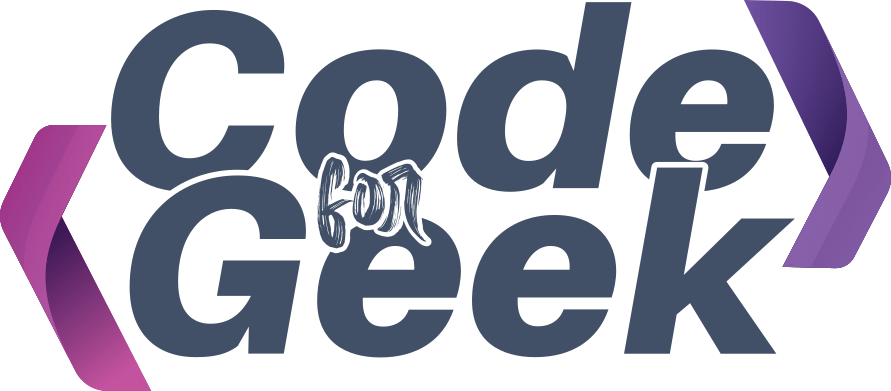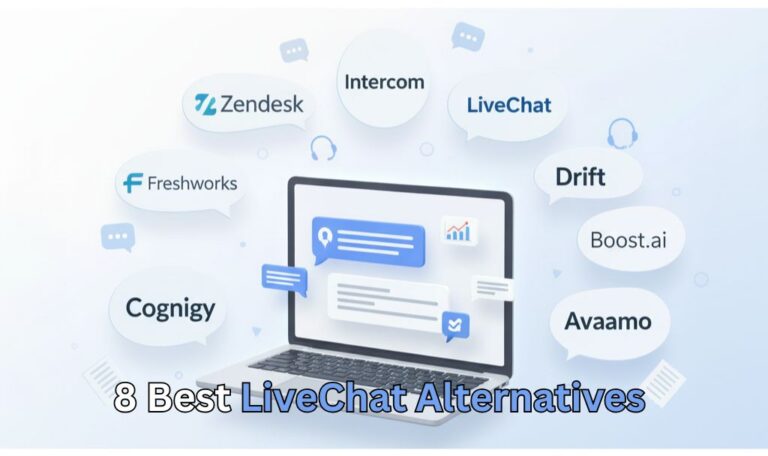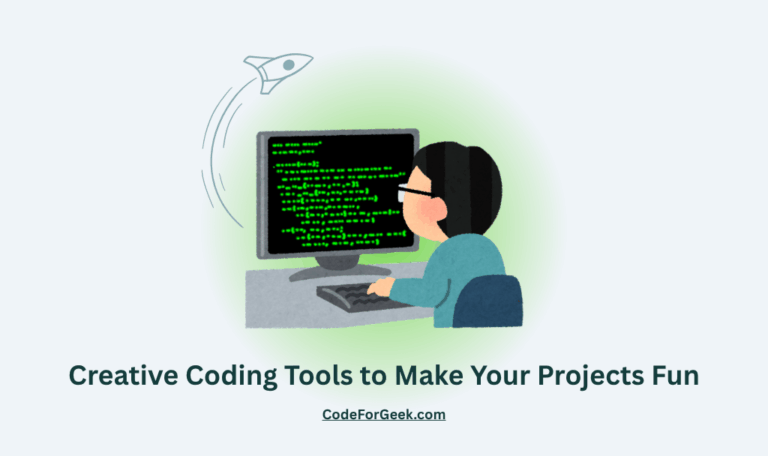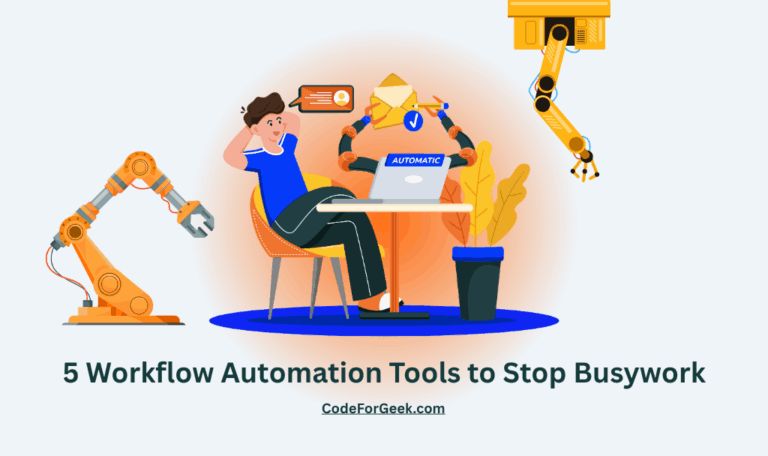Before exploring alternatives, let’s see what LiveChat offers. It focuses on real-time conversations, providing a fast, simple, and highly customisable chat experience. It’s ideal for connecting instantly with website or app visitors without the complexity of full helpdesk systems.
However, LiveChat has some limitations:
- Not a Full Helpdesk: Lacks advanced ticketing tools.
- Costs Rise With Agents: Pricing grows per seat.
- Bot Add-On: AI chatbot is sold separately.
- Lower Plans Limited: Entry tiers restrict features and chat history.
So, if you’re looking for a better fit, here are the best LiveChat alternatives in 2025, starting with a quick comparison table for those in a hurry.
Best Tools to Replace LiveChat in 2025
Here’s a quick table of the best LiveChat alternatives in 2025.
| Tool | Best For | Key Strength | Pricing Starts At |
|---|---|---|---|
| LiveChatAI | Businesses needing AI + human blend | AI chat automation with seamless human fallback | Free / $39/mo |
| Intercom | SaaS & digital-first companies | In-app chat + AI-driven automation | $29/seat/mo |
| Zendesk | Mid to large businesses | Scalable omnichannel suite with analytics | $19/agent/mo |
| Drift (Salesloft) | B2B sales teams | Lead qualification and instant sales engagement | ~$2,500/yr |
| DeepConverse | Zendesk/Salesforce users | Plug-and-play chatbot for ticket deflection | ~$52/mo |
| Aisera | IT, HR, & customer service | Unified AI service desk with automation | Custom |
| CoRover.ai | Asian enterprises & governments | Multilingual, omni-channel AI with BharatGPT | Custom |
| Avaamo | Enterprises in regulated sectors | Vertical AI for banking, healthcare, insurance | Custom |
Next, we will dive deeper into each tool, exploring their features, pros, and cons.
In-Depth Comparison of LiveChat Alternatives
LiveChatAI
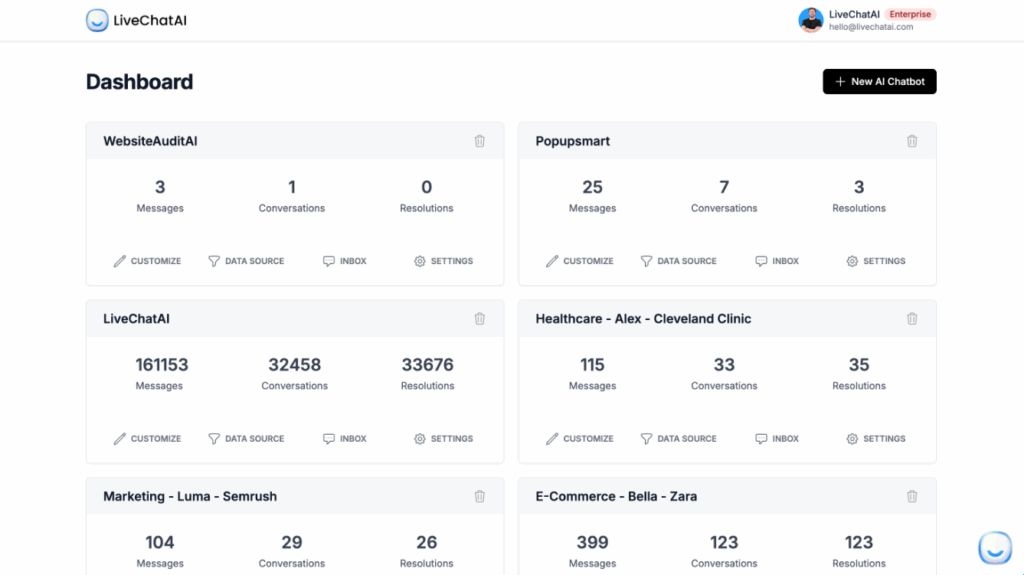
No doubt, LiveChat is excellent for real-time human chat, but its AI features are not built in. To add automation, you need a separate chatbot or third-party service. LiveChatAI solves this limitation by combining AI-driven automation with smooth human fallback in one platform. It can handle up to 70% of routine queries instantly, while complex issues are escalated to a live agent without losing conversation context.
Key Features:
- Dual Response: AI resolves FAQs and passes complex queries to humans.
- Seamless Handoff: Transfers to your team via Intercom, WhatsApp, SMS, or email.
- Knowledge Training: Learns from FAQs, documents, and website content.
- Multi-Channel Deployment: Works on websites, WhatsApp, Shopify, Slack, and WordPress.
- AI Actions & API: Can reset passwords, check orders, or book appointments.
- Analytics: Monitors resolution rates, response times, and satisfaction.
Pros:
- Balanced Support: Automation plus human backup keeps quality high.
- Cost Savings: Reduces repetitive queries so agents focus on complex cases.
- User Experience: Smooth transition between AI and human agents.
- Channel Reach: Covers web chat and popular messaging apps.
- Quick Setup: Templates and knowledge uploads make deployment faster.
Cons:
- Outsourced Handoff: Using external agents may raise quality or privacy concerns.
- Pricing Complexity: Costs vary by usage and added services.
- Integration Effort: Requires setup for CRM or workflow connections.
- Smaller Ecosystem: Newer platform with fewer third-party references.
Pricing:
| Plan | Price | Core Features |
|---|---|---|
| Free | Free | 250 messages, 1 chatbot, live chat, basic analytics, etc. |
| Basic | $39 | 4,000 messages, 1 chatbot, live chat, contacts, etc. |
| Pro | $89 | 10,000 messages, 2 chatbots, AI actions, API access, etc. |
| Advanced | $189 | 15,000 messages, 5 chatbots, WhatsApp integration, advanced models, etc. |
| Expert | $389 | 20,000 messages, 10 chatbots, more seats, advanced analytics, remove branding, etc. |
Best For:
LiveChatAI is best for businesses that want automation without sacrificing the human touch. It suits e-commerce, SaaS, and financial services that need 24/7 support with smooth AI-human collaboration.
Intercom
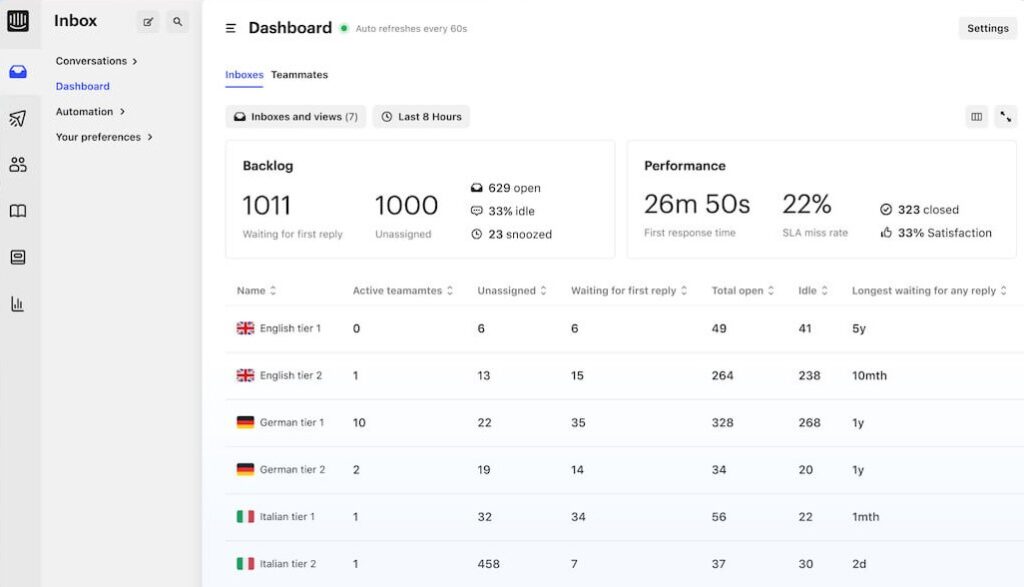
Among modern tools, Intercom stands out because it shifts the focus from tickets to conversations. It’s a platform designed to keep support inside the product, not hidden in a portal. It combines live chat, proactive outreach, and AI-driven automation in one place. The result is a system that feels more personal and less transactional, which is why many SaaS and digital-first companies prefer it.
Key Features:
- Messenger: In-app and web chat widget with user data and context.
- Fin AI Agent: GPT-4 powered bot that answers FAQs from your knowledge base.
- Outbound Campaigns: Targeted messages for onboarding and updates.
- Shared Inbox: Unified email and chat inbox with assignments.
- Knowledge Base: Help centre and product tours to reduce ticket load.
Pros:
- Real-Time Engagement: Excellent in-app chat experience.
- Personalisation: Segments and targets messages by user data.
- Unified Platform: Handles both support and customer outreach.
- Clean Interface: Easy for teams to learn and use daily.
- Strong Ecosystem: Integrates with CRMs and analytics tools.
Cons:
- High Pricing: Per-seat costs and usage fees rise quickly.
- Unpredictable Billing: AI resolution charges can spike costs.
- Limited for Small Teams: Overkill for startups or small businesses.
- Marketing Gaps: Advanced marketing features require third-party tools.
Pricing:
| Plan | Price (per seat/month) | Core Features |
|---|---|---|
| Essential | $29 | Messenger, Fin AI Agent, shared inbox, help centre, reports, etc. |
| Advanced | $85 | All Essential + workflows, multiple inboxes, private/multilingual help centre, etc. |
| Expert | $132 | All Advanced + SSO, HIPAA, SLAs, multibrand support, etc. |
Best For:
Intercom is best for mid-sized and enterprise SaaS companies that want to connect users directly inside apps and websites. It is ideal for teams that need support, onboarding, and customer engagement in one system, provided they have the budget.
Zendesk
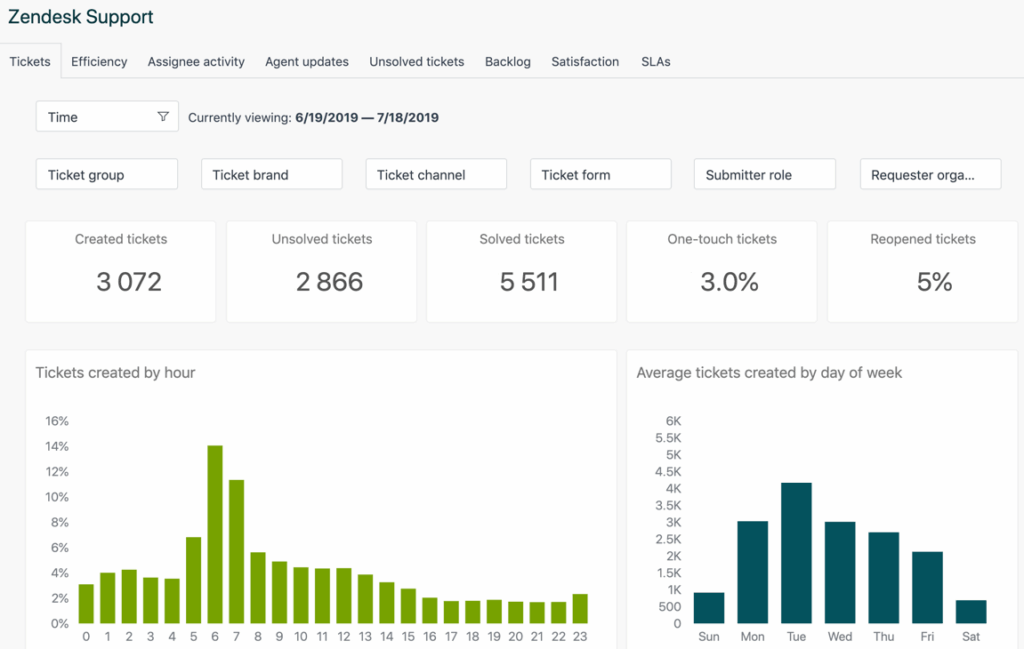
When I review support platforms, Zendesk always feels like the benchmark. It is one of the oldest names in customer service software, and it has evolved into a full support suite that combines ticketing, automation, and analytics. The appeal of Zendesk is not about being trendy, it is about being reliable at scale.
Key Features:
- Omnichannel Ticketing: Centralises email, chat, phone, and social into one ticketing hub.
- AI and Automation: Bots, routing, and workflows to cut manual effort.
- Integrated Voice: Built-in call centre with IVR, call recording, and voicemail.
- Analytics & Reports: Dashboards and custom metrics for SLA, CSAT, and team performance.
- Marketplace: 1,000+ integrations with CRMs, ecommerce, and productivity apps.
Pros:
- Comprehensive Suite: Covers tickets, chat, phone, and self-service.
- Automation Strength: Improves productivity and resolution speed.
- Advanced Analytics: Tracks KPIs and service quality effectively.
- Flexible Setup: Wide configuration and integration options.
Cons:
- High Pricing: Advanced features require costly tiers.
- Steep Learning Curve: Complex UI needs proper training.
- Developer Dependence: Customisation often requires technical support.
- No Free Plan: Only a limited trial is available.
Pricing:
| Plan | Price (per agent/month) | Core Features |
|---|---|---|
| Support Team | $19 | Email, ticketing, Facebook/X support, analytics dashboards, etc. |
| Suite Team | $55 | AI agents, generative replies, knowledge base, chat, social messaging, etc. |
| Suite Professional | $115 | Multiple help centres, advanced reporting, CSAT surveys, SLA management, IVR, etc. |
| Suite Enterprise | $169 | 300 help centres, sandbox, custom roles, audit logs, advanced security, etc. |
Best For:
Zendesk is best for medium to large businesses that need a scalable, AI-driven support hub. It is also ideal for fast-growing startups with high ticket volumes that require robust automation and reliable reporting.
Drift (now part of Salesloft)
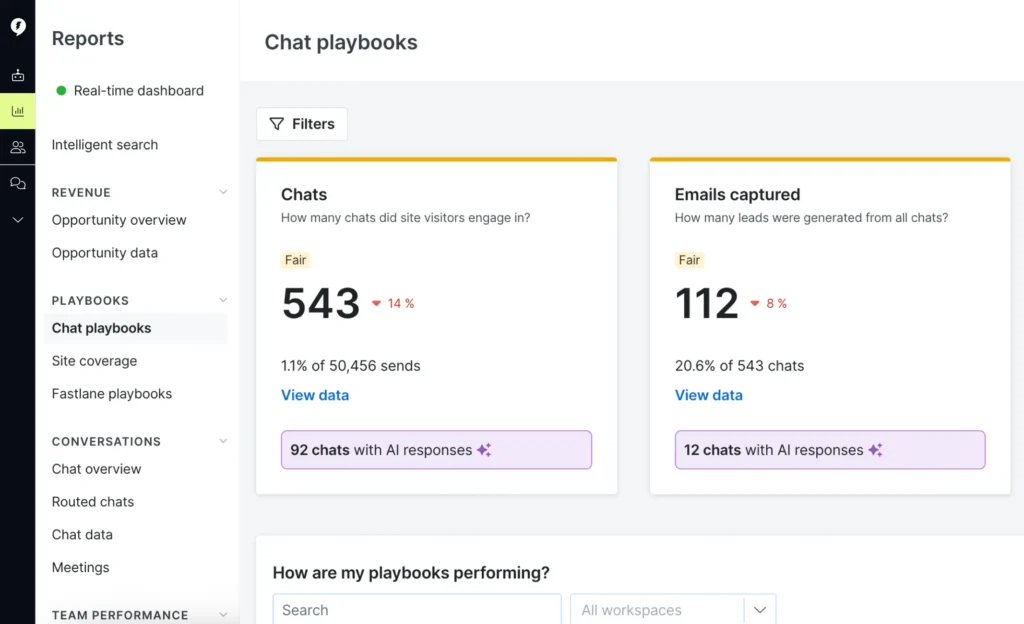
Moving forward, Drift is different from traditional support platforms because it is built for sales and marketing. Instead of managing tickets, it focuses on turning website visitors into qualified leads. Drift replaces static forms with chatbots that engage prospects, ask qualifying questions, and connect them directly to sales reps. If your priority is generating pipeline, Drift is designed for that exact purpose.
Key Features:
- AI Chatbot Playbooks: Predefined scripts that qualify leads by asking about budget, needs, or timeline.
- Live Handoff: Connects hot prospects to the right sales rep in real time.
- Meeting Scheduler: Lets users book demos or calls directly inside the chat.
- Company Intel: Identifies visitor industry and firmographics for personalised greetings.
- CRM Integrations: Syncs with Salesforce, HubSpot, and marketing automation tools.
Pros:
- Boosts Conversions: Replaces slow forms with instant conversations.
- Sales Acceleration: Quickly connects qualified leads to sales reps.
- Integrated Scheduling: Eliminates back-and-forth for demo bookings.
- Enterprise Ecosystem: Strong integrations for CRM and marketing workflows.
Cons:
- Not Designed for Support: Lacks advanced ticketing or helpdesk features.
- High Pricing: Premium plans are expensive for smaller teams.
- Hidden Costs: Advanced features like routing or A/B testing sit on higher tiers.
- Sales-Only Focus: Limited use for customer service functions.
Pricing:
| Plan | Price (annual billing) | Core Features |
|---|---|---|
| Premium | $2,500+ | Live chat, meetings, chatbots, notifications, etc. |
| Advanced | Custom | Adds advanced routing, A/B testing, and support options, etc. |
| Enterprise | Custom | Tailored enterprise-level deployment and features, etc. |
Best For:
Drift is best for B2B companies with significant inbound traffic and structured sales teams. It works particularly well for SaaS, enterprise software, and consulting businesses that need real-time engagement to convert leads into opportunities.
DeepConverse
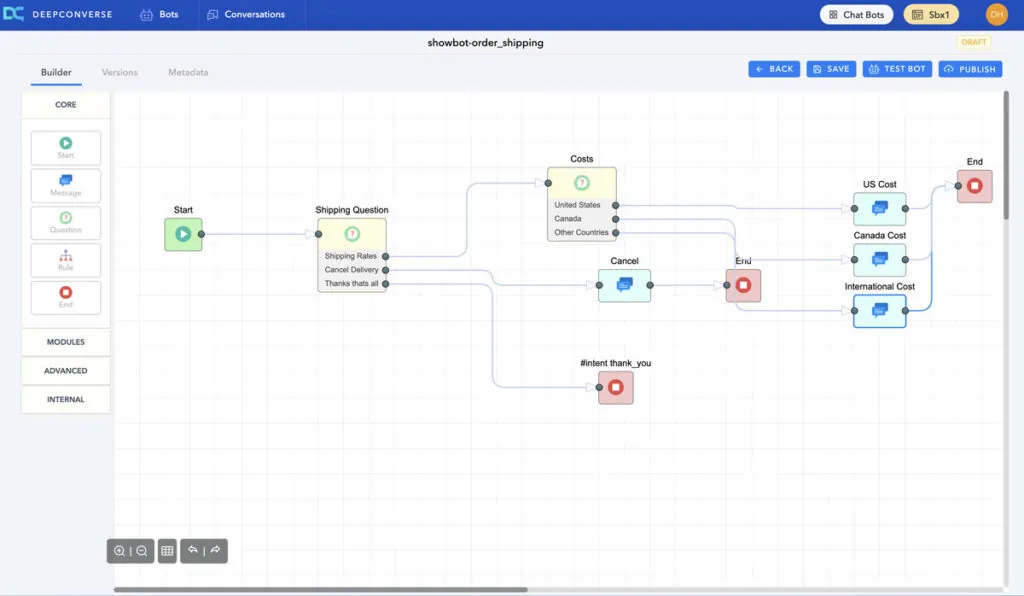
Next on the list is DeepConverse, a chatbot platform designed to work smoothly with helpdesks like Zendesk and Salesforce. It focuses on resolving repetitive support queries through AI-powered responses and guided flows. The setup is straightforward, even for non-technical teams, which makes it appealing for companies that want automation without heavy coding or long implementation cycles.
Key Features:
- Helpdesk Integration: Connects natively with Zendesk and Salesforce for tickets and knowledge articles.
- Generative Answer Engine: Pulls accurate answers directly from FAQs and manuals.
- Interactive Guides: Step-by-step workflows for troubleshooting and Tier 1 automation.
- No-Code Builder: Drag-and-drop interface to design chatbot flows without coding.
- Analytics: Tracks deflection rates, resolution quality, and satisfaction scores.
Pros:
- Plug-and-Play: Works seamlessly with existing helpdesk tools.
- Fast Deployment: Easy setup with templates and no-code builder.
- High Automation: Handles repetitive queries and reduces agent workload.
- Multi-Channel Support: Works on web, mobile, and social platforms.
Cons:
- Zendesk-Centric: Best for Zendesk users; others may require more setup.
- Smaller Market Presence: Less recognition compared to larger vendors.
- Mobile SDK Gaps: Limited standalone mobile SDK options.
Pricing:
| Plan | Price | Core Features |
|---|---|---|
| Base Plan | ~$52/month | Zendesk integration, knowledge base answers, templates, etc. |
| Custom | Quote-based | Advanced flows, analytics, integrations, etc. |
Best For:
DeepConverse is best for companies already using Zendesk or Salesforce that want an AI layer to automate repetitive queries. It suits SaaS, ecommerce, and fintech firms with a knowledge base that can be leveraged for fast deflection.
Aisera
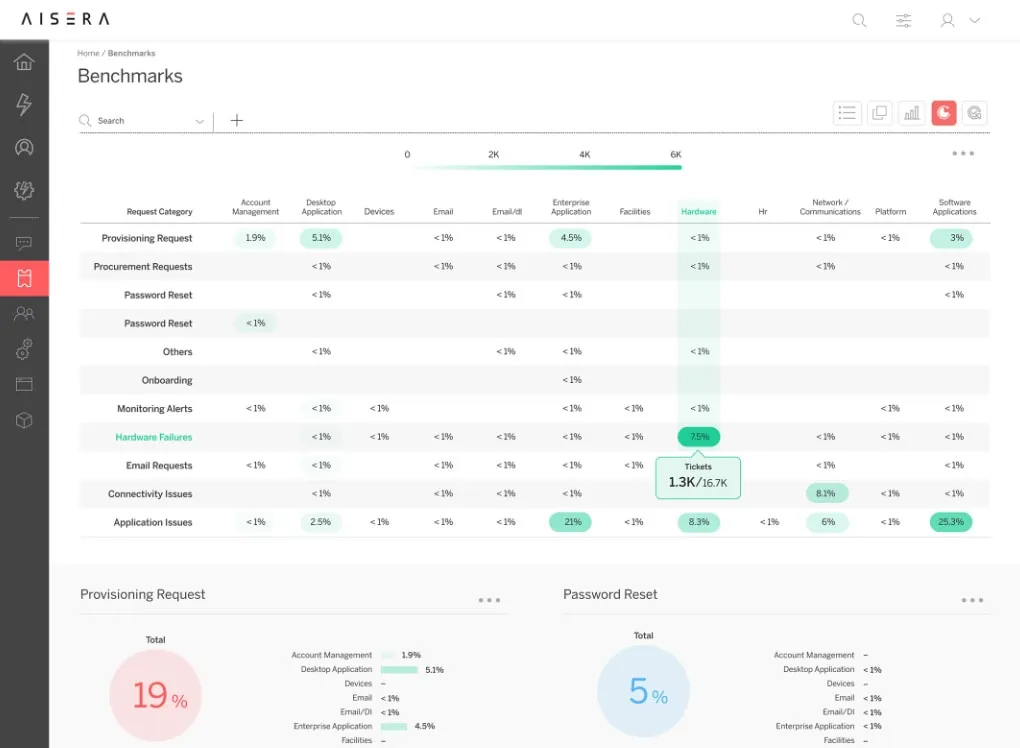
Aisera positions itself as more than just a chatbot. It works as an AI service desk that automates repetitive tasks across IT, HR, and customer support. The platform integrates with existing tools instead of replacing them, making it useful for enterprises that already run systems like Zendesk, ServiceNow or Salesforce. Its focus is on high auto-resolution, workflow execution, and acting as a co-pilot for agents.
Key Features:
- Unified AI Service Desk: One virtual agent for IT, HR, and support requests.
- Workflow Automation: Handles tasks like password resets and license provisioning.
- Multi-Channel Support: Works across chat, voice, email, and collaboration apps.
- Knowledge Search: AI-driven search across FAQs, tickets, and documents.
- Agent Assist: Suggests next-best actions and answers to live agents.
- Integrations: 75+ certified connectors with ITSM, CRM, and IAM systems.
Pros:
- High Auto-Resolution: Resolves up to 80% of routine queries.
- Cross-Department Use: Consolidates IT, HR, and support into one AI layer.
- Vendor-Agnostic: Works alongside existing platforms.
- Fast Deployment: Pre-trained intents allow quick setup.
- Scalable: Expands coverage with minimal retraining.
Cons:
- Enterprise Pricing: Suited only for large organisations.
- Implementation Effort: Requires setup and data preparation.
- Admin Learning Curve: Workflow and analytics need training.
- Monitoring Needed: AI-driven actions require oversight to build trust.
Pricing:
| Plan | Price | Core Features |
|---|---|---|
| Custom | Quote-based | Unified AI desk, workflow automation, multi-channel support, integrations, etc. |
Best For:
Aisera is best for large enterprises and fast-growing organisations with heavy service desk demand. It fits IT, HR, and customer support teams that need to automate repetitive tasks, improve efficiency, and scale without adding headcount.
CoRover.ai
To wrap up this list, I looked into CoRover.ai, a conversational AI platform that has made its mark in Asia, especially in large-scale deployments. What makes it stand out is its ability to support chat, voice, and even video bots across multiple languages. A well-known example is its use in Indian Railways, where it manages millions of daily queries. CoRover also developed BharatGPT, a regional large language model tuned for local languages and responsible AI.
Key Features:
- Omni-Channel Assistants: Chat, voice, and video bots on web, apps, WhatsApp, IVR, and more.
- Multi-Language NLP: Supports 100+ global languages and 13+ Indian languages.
- BharatGPT: Generative AI tuned for regional accuracy and contextual responses.
- Fast Deployment: Chatbot-as-a-Service model enables quick rollout.
- Enterprise Integrations: Pre-built connectors for CRM, ERP, banking, and ticketing.
- Security & Compliance: ISO 27001, GDPR, and HIPAA-ready with encryption and audit logs.
Pros:
- Proven at Scale: Handles billions of interactions in government and enterprise use.
- Strong Language Coverage: Ideal for multilingual deployments in Asia.
- Fast Implementation: Up to 10x quicker deployment with CaaS model.
- High ROI: Deflects repetitive queries and reduces operational costs.
- Versatile Use Cases: Customer support, HR, grievance handling, and lead generation.
Cons:
- Enterprise-Level Pricing: Costs are not public and aimed at large organisations.
- Limited Global Reach: Strong in Asia but less presence in Western markets.
- Newer LLM Offering: BharatGPT adoption outside Asia is still limited.
Pricing:
| Plan | Price | Core Features |
|---|---|---|
| Custom | Quote-based | Multilingual bots, omni-channel support, enterprise integrations, security, etc. |
Best For:
CoRover.ai is best for enterprises and government organisations in Asia that need multilingual and multimodal bots at scale. It is ideal for banks, telecoms, and public services that want secure AI with strong local language support.
Avaamo
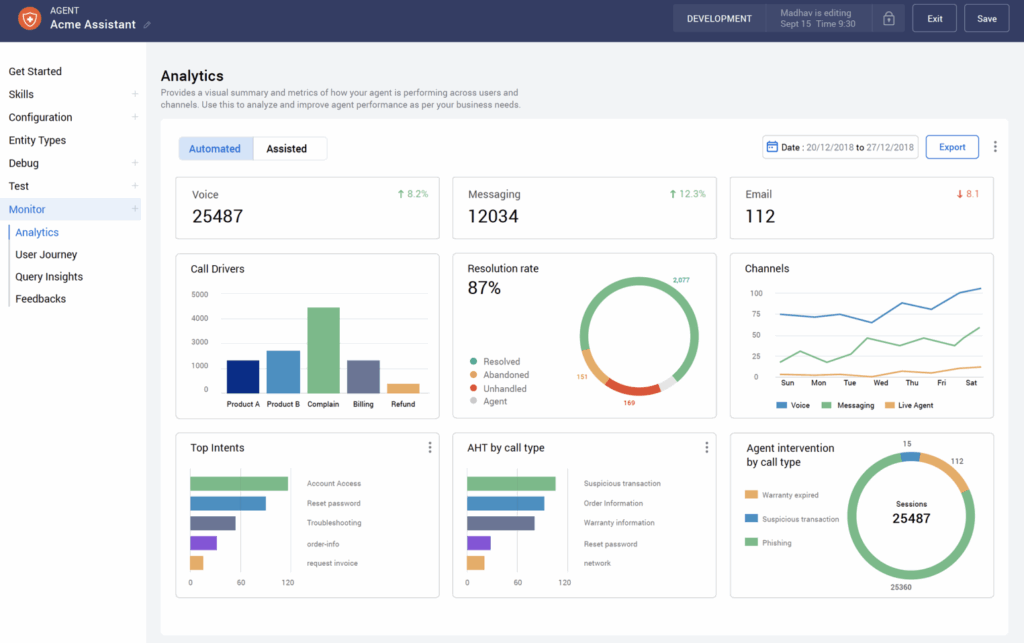
If you are looking for a vertical-specific AI model, Avaamo is a great choice. It’s an enterprise-grade conversational AI platform built for complex industries like banking, healthcare, and insurance. Unlike generic chatbot tools, Avaamo offers industry-tailored AI models, strong compliance, and robust data security. It’s designed to manage large-scale, multi-turn conversations across both chat and voice, making it a reliable choice for businesses that prioritise accuracy and security.
Key Features:
- Vertical AI Models: Pre-trained for finance, healthcare, insurance, and HR.
- No-Code Builder: Visual designer to create workflows without coding.
- Multilingual Support: 100+ languages and dialects for global deployments.
- Voice + Chat: Works across SMS, IVR, mobile, and web channels.
- Enterprise Integrations: 1,000+ connectors for CRM, ERP, ITSM, and more.
- Security & Compliance: SOC2, HIPAA, and GDPR ready with role-based access.
Pros:
- Industry-Specific Expertise: Comes ready with models for regulated sectors.
- Strong Automation: Handles complex queries with high accuracy.
- Flexible Deployment: Cloud or on-premise options.
- Comprehensive Analytics: Tracks containment, CSAT, and intent failures.
- Scalable: Supports large enterprises with high volumes.
Cons:
- Premium Pricing: Aimed at large enterprises only.
- Complex Setup: Deep integrations require technical expertise.
- Steep Learning Curve: Non-technical teams may need support.
- Cross-Channel Context: Conversations do not always carry over seamlessly.
Pricing:
| Plan | Price | Core Features |
|---|---|---|
| Custom | Quote-based | Enterprise deployment, vertical AI models, omnichannel support, etc. |
Best For:
Avaamo is best for large enterprises in regulated industries such as banking, insurance, and healthcare. It is suited for organisations that need secure, scalable, multilingual AI with deep integrations and compliance at the core.
These are the top LiveChat alternatives to help you find the right fit for your business.
